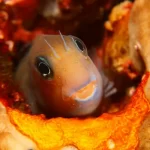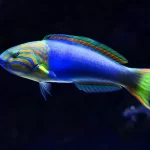If you’re an aquarium hobbyist, you’d know that Kuhli Loach fish is a vital part of aquarium hobby for several years now. It is a unique fish with striking color and with the form of an eel. Kuhli Loaches are great ones for experts as well as beginners as they are peaceful and undemanding in nature, apart from being great fun to watch.

The Kuhli Loach or Pangio kuhlii is a unique fish that is not just small but also a friendly creature that is usually found in Asia. These fishes come in elongated bodies with a ‘cucumber’ on their heads that help them in breathing when they reach above the surface of the water. This species can in this way get a supplement through their dorsal fins and gills.
Taking care of a Kuhli Loach can seem to be difficult but that doesn’t make it impossible. They are very common aquarium fishes that need special attention with regard to feeding and food, choosing tank mates, and mating. Keep reading to know more about all the details of this species of fish called Kuhli Loach.
Quick Facts on Kuhli Loach
| Family: | Cobitidae |
| Origin: | Southeast Asia |
| Temperament: | Peaceful |
| Size: | 3-4 inches |
| Minimum Tank Size: | 15 Gallons |
| Diet: | Omnivore, live foods |
| Care: | Intermediate |
| pH: | 6.0 – 6.5 |
| Alkalinity Levels: | Up to 10dGH |
| Temperature: | 75 to 86 degrees F (24 to 30 degrees C) |
Distribution and Origin of Kuhli Loach
This species of fish called the Kuhli Loach is usually found in Southeast Asia and countries like Malaysia, Thailand, Indonesia, and in the ponds and rivers of Vietnam. Apart from these native countries, they have also been brought to other places like Japan, Singapore, Papua New Guinea, Taiwan, and also the US.
Though Kuhli Loaches are not typical schooling species these fishes are highly social and usually form groups in the wild. Within their natural habitat, the Kuhli Loaches are nocturnal creatures that keep hunting the riverbed in search of food. These fishes are highly common in the wild and there are many fishes that are caught wild rather than being put inside the aquarium for domestic use.
Lifespan and Size of Kuhli Loach
The adult loaches can grow up to a length of three to four inches long both in the wild and inside the aquarium. The females and males usually grow up to the same length but the males have longer pectoral fins and their dorsal cross-section is a little bit thicker than that of females. The females also have bellies that are rounder in shape than males, and it gets even more round during the time of breathing.
The average lifespan of a Kuhli Loach is from 7 to 10 years. But if you can keep it in a tank with the most ideal environmental conditions, a Kuhli Loach longa up to a maximum of 14 years.
The behavior of a Kuhli Loach
Though their appearance is extremely striking, they choose to stay alone and are typically calm by nature. A Kuhli Loach will love to spend a whole day swimming around the decorations made inside the aquarium and the plants and since they are nocturnal, you can also find them lurking around at night. It is tough to find them out in the aquarium during this time because they are mostly hiding behind plants.
When it is extremely dark at night, they tend to eat during this time and this is why you will not find them during the day even if your fish tank is illuminated properly. Kuhli Loaches tend to spend a lot of time down at the river bed or in the natural environment. This is why this species of fish is highly sensitive to the alterations in the quality and chemistry of water.
In case the spaces get surprised or jolted due to some unexpected movement nearby, they will instantly escape taking shelter behind the plants.
Appearance and color of a Kuhli Loach
One of the first character traits that you will notice when differentiating Kuhli Loaches from other species of fish is their unique yet striking appearance. The stripes and colors that you may find on a Kuhli Loach will vary depending on their diet, natural habitat, and also the place in which they live.
Usually, It is seen that the skin of a Kuhli Loach is either Orange or bright yellow in color with dark spots all over it, giving it a look similar to a Leopard print. The eyes of a Kuhli Loach are covered by a thin transparent layer of skin, which boosts their capability to visualize things in the dark and provides them with a sense of feeling that warns them of any potential danger.
The fins of a Kuhli Loach usually come in different colors that are basically translucent and there are other colors that are orangish and reddish in tone. A Kuhli Loach possesses two sets of barbels, one on each side of their mouth, which helps them in navigating through water.
There are also different species of the same fish that have black stripes across their faces and others have red streaks flowing from their nose to eye portion. Their back portions are usually lighter in color than their upper portion, however, this is only visible when they come in contact with other fishes at night.
Differences in gender
One of the key ways of knowing and being certain of whether a Kuhli Loach is a male or female is through venting. All you need to do is turn them over and press their stomachs to see whether they are discharging eggs. If it is a female, it will release eggs and if it is a male, it will have enlarged claspers.
The male Kuhli Loaches have one more distinct feature they own one on each side of their dorsal fin where it meets their body and has two white patches. If you view these fishes from the top side, a male Kuhi is a bit smaller than a female Kuhi. Hence, they can squeeze themselves into very small spaces especially when they need privacy for courtship rituals with other males.
How to take care of a Kuhli Loach
This is not a breed that is very simple to take care of and it can get challenging for the aquarists who have developed this hobby lately. Here are a few important things to keep in mind.
DIET and FOOD
As long as taking care of a Kuhli Loach is concerned, the best component is their diet and food. They are extremely natural omnivores that eat anything that fits inside their mouth. A Kuhli Loach will eat insects, crustaceans, and other plant materials in the wild. When they are placed inside a home fish tank, you can give them algae wafers, sinking pellets, and fresh veggies like spinach leaves or romaine lettuce. You can also offer squash cubes, zucchini, and other leafy vegetables. Live meals are even better options that include water fleas, bloodworms, tubifex, and brine shrimp.
WATER CONDITIONS
The Kuhli Loach is a subtropical fish that survives in a temperature that ranges from 73 to 86 degrees. This is the most effective temperature for a Kuhli Loach as it perfectly resembles its native surroundings. A Kuhli Loach is highly versatile and hence it can perform well even in slightly warmer or cooler waters as long as the temperature is within the mentioned range.
Waters with a pH level of 5.5-6.6 is considered highly acidic and the water should also have a hardness level of 5.0 dGH or even less than that. It is important to maintain a good filter if you want to improve the movement of water with at least 10 times per hour turnover.
Soft substrates like gravel mix or fine sand can be mixed together for moderate lighting. If you think it is necessary, you can add crushed coral or dolomite to bring the pH closer to the neutral level. A Kuhli Loach is habituated to a lot of greenery and hence you should use a lot of plants like Java Fern and Cryptocoryne while decorating the fish tank.
MINIMUM SIZE OF TANK
If you have to avoid issues keeping a Kuhli Loach in your aquarium, you should know the minimum size of the tank that can keep such a species. As these fishes are comparatively small, the minimum tank size should be 15 gallons. But if you plan to have more than one patient, you can add additional gallons for each additional Kuhli Loach.
Breeding tips
Breeding Kuhli Loaches is a daunting task. These fishes are totally stubborn and they look for a certain environment to mate. As the male and female fishes are not two different from each other, the first step that the breeder needs to take is sexing them. You have to differentiate the males from the females as they are almost identical.
A Kuhli Loach will not reach a stage of maturity and less they become two years of age. when a female is ready to spawn, they become round in shape and their ovaries can also be seen through their skin. You have to make them as comfortable as they can if you have to breed them.







